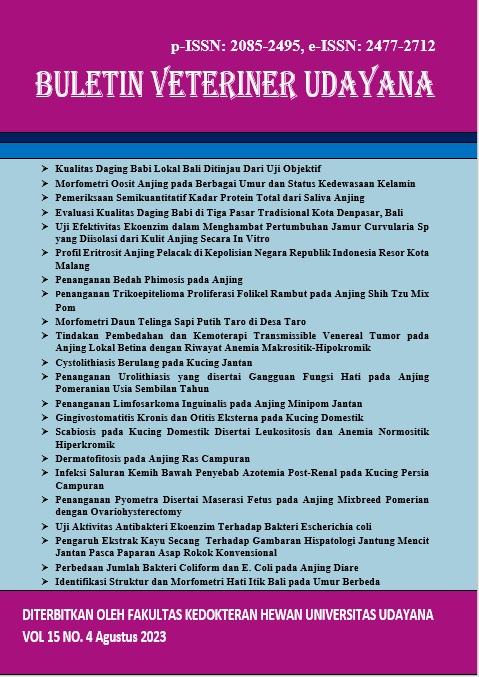SCABIOSIS IN DOMESTIC CATS
Abstract
Scabies is a skin disease that dominates both domesticated and wild cats caused by the zoonotic mite Sarcoptes scabiei. The purpose of writing this article is to provide information about the impact of scabies infection in cats and the appropriate treatment and handling given to cats with scabies cases. Examination was carried out on domestic cats with anamnesis showing symptoms of itching by scratching the ears against the wall or ground and found lesions on the ears. The results of clinical examination showed hyperkeratosis and alopecia in the ear. Investigations using skin scraping or skin scraping under a microscope showed Sarcoptes scabiei mites, while hematological examination revealed that the cat had leukocytosis and hyperchromic normocytic anemia. Based on the history, clinical examination and supporting examination, the cat was diagnosed with scabiosis. The therapy given is in the form of causative, symptomatic, and supportive therapy. The causative therapy given was ivermectin with a dose of 0.2 ml/kg body weight with two doses at an interval of 14 days. Symptomatic therapy given is Chlorpheniramine maleate given at a dose of 2 mg/kg body weight, every 12 hours, for five days. Supportive therapy is given in the form of Vita-Gel 50 g given the size of three corn kernels (1-3 cm) 2-3 times a day for 10 days, and animals are bathed using sulfur soap twice a week. The therapy given to the Pisci cat showed good results where the cat showed changes from the beginning until after the treatment the pruritus and hyperkeratosis began to decrease and the hair started to grow. If the owner's cat has scabies, immediately separate it from their pets so that scabies does not spread to other animals.
Downloads
References
Aranzazu GC, Ana M, Sahagu´n PM, Liebana JD, Martinez LZ, Vega MS, Juan J, Vieitez G. 2007. The pharmacokinetics and metabolism of ivermectin in domestic animal species. Department of Biomedical Sciences. Veterinary Faculty, University of Leon. Spain.
Bijanti R, Yulianti MGA, Wahjuni RS, Utomo RB. 2010. Buku ajar patologi klinik edisi pertama. Surabaya. Airlangga University Press. Pp. 13-14.
Dewi MK, Wathoni N. 2017. Article review: diagnosis dan regimen pengobatan skabies. Farm. Supl. 15(1): 123-133.
Diwakar RP. 2017. Canine scabies: a zoonotic ectoparasitic skin disease. Int. J. Curr. Microbiol. App. Sci. 6(4): 1361-1365.
Hardy JI, Sinclair G, Fox MT, Loeffler A. 2016. Feline sarcoptic mange in the UK: a case report.
Howard B. 2020. How to identify and treat your cat for mange. https://www.dailypaws.com/ Accessed on 10 November 2021.
Ilman ZA, Ida S,Wiji A, Ika RS. 2017. Perbandingan efektivitas sabun sulfur 10% dengan salep 2-4 sebagai pengobatan tunggal dan kombinasi pada penyakit skabies. J. Agromed. Med. Sci. 3(3): 1-5.
Ludmerer SW, Warren VA, Williams BS, Zheng Y, Hunt DC, Ayer MB, Wallace MA, Chaudhary AG, Egan MA, Meinke PT, Dean DC, Garcia ML, Cully DF, Smith MM. 2002. Ivermectin and nodulisporic acid receptors in Drosophila melanogaster contain both gamma-aminobutyric acid-gated Rdl and glutamate-gated GluCl alpha chloride channel subunits. Biochemistry. 41(20): 6548-6560.
Palguna D. 2014. Sistem pakar diagnosis penyakit kulit pada kucing menggunakan metode certainty factor. JSIKA. Pp. 75.
Pudjiatmoko, Syibli M, Nurtanto S, Lubis N, Syafrison, Yulianti S, Kartika D, Yohana CK, Setianingsih E, Efendi ND, Saudah E. 2014. Manual penyakit hewan mamalia. Subdit Pengamatan Penyakit Hewan Direktorat Kesehatan Hewan Direktorat Jenderal Peternakan dan Kesehatan Hewan Kementerian Pertanian. 2nd printing. Pp. 438-446.
Reddy BS, Kumari KN, Sivajothi S. 2014. Thyroxin levels and Haematological changes in dogs with Sarcoptic mange. J. Adv. Parasitol. 1(2): 27–29.
Senthil K, Selvaraj P, Vairamuthu S, Srinivasan SR, Kathiresan D. 2008. Ivermectin therapy in the management of notoedric mange in cats. Tamilnadu J. Vet. Anim. Sci. 4(6): 240-241.
Sivajothi S, Reddy BS, Venkatasivakumar R. 2015. Chronic dermatitis complicated with otitis due to Notoedrescatiin a Persian cat. J. Adv. Parasitol. 2(1): 19-22.
Sivajothi S, Reddy BS, Rayulu VC, Sreedevi C. 2014. Notoedrescatiin cats and its management. J. Parasit. Dis. 39(2): 303–305
Susanto H, Kartikaningrum M, Wahjuni RS, Warsito SH, Yuliani MGA. 2020. Kasus scabies pada klinik Intermedipet Surabaya. J. Biosains Pascasarjana. 22: 37-45.
Weiss DJ, Wardrop KJ. 2010. Schalm’s veterinary hematology 6th ed. Ames, Iowa, USA: Blackwell Publishing Ltd. Pp. 797.
Wolstenholme AJ. 2011. Ion channels and receptor as targets for the control of parasitic nematodes. Int. J. Parasitol. Drugs and Drug Resistance. 1(1): 2-13.
Yates DM, Portillo V, Wolstenholme AJ. 2003. The ivermectin receptors of haemonchus contortus and caenorhabditis elegans. Int. J. Parasitol. 33(11): 1183- 1193.





